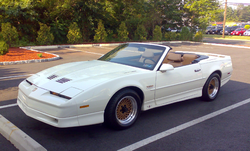Third generation Pontiac Trans Am/Firebird (1982–1992)
 | |
| Production | 1982–1992 |
|---|---|
| Assembly | Van Nuys, California, United States Norwood, Ohio, United States |
| Body style | 3-door hatchback coupe, 2 door convertible |
| Layout | FR layout |
| Platform | F-body |
| Engine | 151 cu in (2.5 L) Pontiac I4 173 cu in (2.8 L) "X" V6 191 cu in (3.1 L) "X" V6 231 cu in (3.8 L) Buick Turbo V6 305 cu in (5.0 L) Chevrolet V8 350 cu in (5.7 L) Chevrolet V8 |
| Transmission | 3-speed automatic 4-speed automatic 4-speed manual 5-speed manual |
| Wheelbase | 101 in (2,565 mm) |
| Length | 1990–92 Firebird: 195.1 in (4,956 mm) 1990-92 Trans Am: 195.2 in (4,958 mm) Pre-1988 Firebird: 190.5 in (4,839 mm) Pre-1988 Trans Am: 191.8 in (4,872 mm) |
| Width | 72.4 in (1,839 mm) |
| Height | 49.7 in (1,262 mm) |
| Related | Chevrolet Camaro (third generation) |

1991 Firebird convertible with restyled nose
The Firebird and Camaro were completely redesigned for the 1982 model year, with the windshield slope set at 62 degrees, (about 3 degrees steeper than anything GM had ever tried before), and for the first time, a large, glass-dominated hatchback that required no metal structure to support it. Two concealed pop-up headlights, a first on the F-Body cars, were the primary characteristic that distinguished the 3rd Gen Firebird from its both its Camaro sibling and its prior form; (a styling characteristic carried into the 4th Gen's design). In addition to being about 500 lbs (227 kg) lighter than the previous 2nd Gen design, the 3rd Generation Firebird was the most aerodynamic product GM had ever released. Wind tunnels were used to form the new F-Body platform's shape, and Pontiac took full advantage of it. The aerodynamic developments extended to the finned aluminum wheels with smooth hubcaps and a functional rear spoiler.
No comments:
Post a Comment